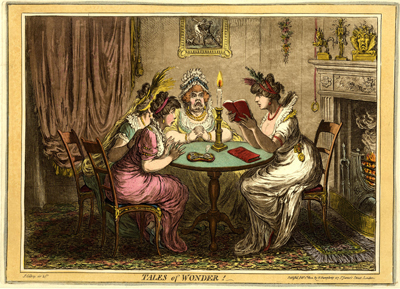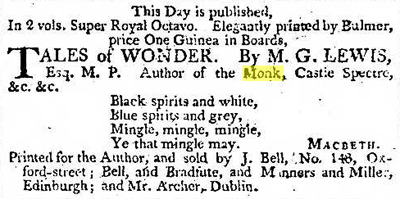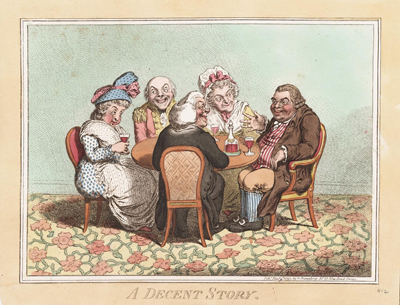Tales of Wonder
Tales of Wonder features four well-dressed ladies sitting around a table as one of them eagerly reads from a book in her hand. According to the watch hanging from an ornamental clasp at her waist, it is already after midnight (12:45 AM). The solitary candle casting appropriately dark shadows throughout the room, has been recently trimmed to extend its life, and there is no sign that any of the women is ready to retire to bed.

© Trustees of the British Museum
The volume on the table is labeled The Monk which may be intended to suggest that the book being read is one of the three volumes of the hugely successful and scandalous novel by that name published by Matthew (soon known as "Monk") Lewis in 1796. But the title of the print, Tales of Wonder, is also the name of an anthology of poems (assembled and mostly written) by Lewis which was first advertised in several newspapers in December, 1801. Following hard upon the publication of the collection of poems, it seems hardly accidental that Gillray's print with the same name is not, somehow connected with the Lewis collection. As he often does, Gillray may have chosen to create the print to take advantage of the popularity of the most recent Monk Lewis production. But perhaps equally probable, Monk Lewis may have decided to commission Gillray's print to help advertise it.

© The Porcupine
This theory may, perhaps, be bolstered by two facts. One is that there was already a connection between Lewis and Gillray. Lewis's name appears on the subscriber's list for the deluxe edition of The Poetry of the Anti-Jacobin advertised in June 1800 with some 30-40 plates by Gillray.* So Lewis was certainly aware of, and willing to pay for, examples of Gillray's talent. The second fact is that in February 1801, the same month as Gillray's print, Lewis published a pseudonymous verse critique of his own work called More Wonders! An Heroic Epistle to M.G. Lewis, Esq by Mauritius Moonshine, in which he anticipates the kind of criticism that his work typically provoked. His willingness to spend money to make fun of himself in print suggests both the deep pockets he procured by the success of The Monk, and his awareness that even negative press is better than no press.
But in fact Gillray's print does not satirize Lewis at all. In most ways, Tales of Wonder falls into what may be called the comedy of expression, where the features of its subjects are caught at an unexpected moment, revealing the humorously unflattering passions of everyday life. Hogarth was a master of this sort of comedy in prints like Scholars at a Lecture (1736) and The Laughing Audience (1733). Bunbury continued the tradition with prints like A Family Piece (1781) and Billiards (1780). And Gillray had already demonstrated his ability to carry on the tradition in A Decent Story (1795) and Two-Penny Whist. But in all of Gillray's examples, he has heightened their universality by choosing to depict situations—men and women gathered around a table to drink, converse, play cards, or read aloud— that virtually anyone in his audience could identify with.

© Lewis Walpole Library, Yale University
The difference between the two earlier examples and Tales of Wonder is that the latter includes backround details such as the skeletal figures, and the two scenes of abduction on the mantelpiece and wall suggesting the fascination of Gothic fiction like The Monk with images of death and decay and the fear and sexual titilation of being carried away.
* Thanks to Tim Clayton for sending me the list of subscribers from the Gillray Additional MSS.
Addendum
Since this commentary was first published in August 2021, Omek Marks has pointed out to me that there is a
later state
of this print with a mock dedication above the image to M.G. Lewis Esq. This fact, I think, further strengthens the theory
that the print was commissioned by Lewis. The dedication does nothing to increase the subtlety or
effectiveness of the print, but it now explicitly advertises the connection with the author of The Monk.
Sources and Reading
- Commentary from the British Museum on Tales of Wonder.
- Draper Hill, Fashionable Contrasts, 1966,
- Draper Hill, The Satirical Etchings of James Gillray, 1976,
- "Matthew Lewis (writer)," Wikipedia
- "The Monk," Wikipedia
- Tales of Wonder - Sampler
- Thomas Wright and R.H. Evans, Historical and Descriptive Account of the Caricatures of James Gillray #514.
- Thomas Wright and Joseph Grego, The Works of James Gillray, the Caricaturist; With the History of His Life and Times, p. 289.
Comments & Corrections
NOTE: Comments and/or corrections are always appreciated. To make that easier, I have included a form below that you can use. I promise never to share any of the info provided without your express permission.